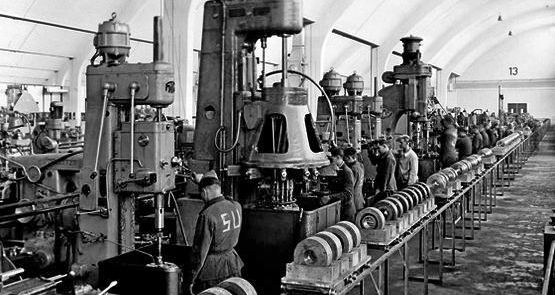
|
May 23, 2015 - No. 21 Supplement Anglo-American and German Capital Behind the Nazi War Machine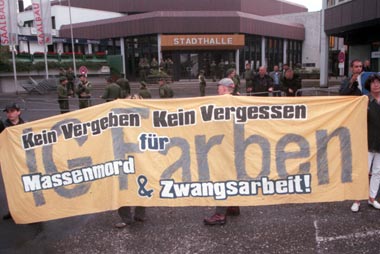 Banner reads: "We don't forgive and we don't forget mass murder and forced labour!" World
War II --
History
• The Class Character of Fascism - Georgi Dimitrov - • INCO Willingly Helped German Aggression - Albert Norden - • Nazi Collaboration and Use of Slave Labour by German Industry: The Example of Audi • The Role of Anglo-American Financiers - Valentin Katasonov - • WW II Lend-Lease: Was the U.S. Aid that Helpful? - Evgeniy Spitsyn - World War II -- History The Class Character of Fascism
The Bulgarian communist leader Georgi Dimitrov was also a leader of the Communist International which played a decisive role in the United Front Against Fascism during World War II. TML Weekly is reprinting below an excerpt from the main report delivered by Dimitrov at the Seventh World Congress of the Communist International on August 2, 1935. The report, entitled "The Fascist Offensive and the Tasks of the Communist International in the Struggle of the Working Class against Fascism," showed amongst other things the need of the monopoly capitalists vying for domination to enslave the working class in order to succeed in their takeover of other countries and the absolute necessity to engage in the resistance struggle to avert the disasters which lay ahead. * * *Comrades, as early as its Sixth Congress, [held in 1928] the Communist International warned the world proletariat that a new fascist offensive was in preparation and called for a struggle against it. The Congress pointed out that "in a more or less developed form, fascist tendencies and the germs of a fascist movement are to be found almost everywhere."
With the development of the present very deep economic crisis, with the general crisis of capitalism becoming sharply marked and the mass of working people becoming revolutionized, fascism has embarked upon a wide offensive. The ruling bourgeoisie more and more seeks salvation in fascism, with the object of taking exceptional predatory measures against the toilers, preparing for an imperialist war of plunder, attacking the Soviet Union, enslaving and partitioning China, and by all these means preventing revolution. Imperialist circles are trying to put the whole burden of the crisis on the backs of the toilers. That is why they need fascism. They are trying to solve the problem of markets by enslaving the weak nations, by intensifying colonial oppression and repartitioning the world anew by means of war. That is why they need fascism. They are striving to forestall the growth of the forces of revolution by smashing the revolutionary movement of the workers and peasants and by undertaking a military attack against the Soviet Union -- the bulwark of the world proletariat. That is why they need fascism. In a number of countries, Germany in particular, these imperialist circles have succeeded, before the masses have decisively turned toward revolution, in inflicting defeat on the proletariat and establishing a fascist dictatorship. But it is characteristic of the victory of fascism that this victory, on the one hand, bears witness to the weakness of the proletariat, disorganized and paralyzed by the disruptive Social-Democratic policy of class collaboration with the bourgeoisie, and, on the other, expresses the weakness of the bourgeoisie itself, afraid of the realization of a united struggle of the working class, afraid of revolution, and no longer in a position to maintain its dictatorship over the masses by the old methods of bourgeois democracy and parliamentarism. The victory of fascism in Germany, Comrade Stalin said at the Seventeenth Congress of the Communist Party of the Soviet Union: . . . must be regarded not only as a symptom of the weakness of the working class and as a result of the betrayal of the working class by Social-Democracy, which paved the way for fascism; it must also be regarded as a symptom of the weakness of the bourgeoisie, as a symptom of the fact that the bourgeoisie is already unable to rule by the old methods of parliamentarism and bourgeois democracy, and, as a consequence, is compelled in its home policy to resort to terroristic methods of administration -- it must be taken as a symptom of the fact that it is no longer able to find a way out of the present situation on the basis of a peaceful foreign policy, as a consequence of which it is compelled to resort to a policy of war. The Class Character of FascismComrades, fascism in power was correctly described by the Thirteenth Plenum of the Executive Committee of the Communist International as the open terrorist dictatorship of the most reactionary, most chauvinistic and most imperialist elements of finance capital. The most reactionary variety of fascism is the German type of fascism. It has the effrontery to call itself National-Socialism, though it has nothing in common with socialism. Hitler fascism is not only bourgeois nationalism, it is bestial chauvinism. It is a government system of political gangsterism, a system of provocation and torture practiced upon the working class and the revolutionary elements of the peasantry, the petty bourgeoisie and the intelligentsia. It is medieval barbarity and bestiality, it is unbridled aggression in relation to other nations and countries. German fascism is acting as the spearhead of international counter-revolution, as the chief instigator of imperialist war, as the initiator of a crusade against the Soviet Union, the great fatherland of the toilers of the whole world. Fascism is not a form of state power "standing above both classes -- the proletariat and the bourgeoisie," as Otto Bauer, for instance, has asserted. It is not "the revolt of the petty bourgeoisie which has captured the machinery of the state," as the British Socialist Brailsford declares. No, fascism is not super-class government, nor government of the petty bourgeoisie or the lumpenproletariat over finance capital. Fascism is the power of finance capital itself. It is the organization of terrorist vengeance against the working class and the revolutionary section of the peasantry and intelligentsia. In foreign policy, fascism is jingoism in its crudest form, fomenting bestial hatred of other nations. [...] (Georgi Dimitroff, The United Front, Proletarian Publishers, San Francisco, 1975)
INCO Willingly Helped German AggressionThe International Nickel Company of Canada, which controlled 85 per cent of world nickel production in the 1930s, delivered nickel to the Hitlerite state for political-military reasons. What follows is an excerpt from Norden’s book Thus Wars Are Made! (German title
of the original German edition: So
werden Kriege gemacht! published by Verlag Zeit im Bild, 1950) ***
Classical evidence of this co-operation for war purposes is contained in the files of the IG Farben trust. At the Nuremberg trial against the IG Farben directors, the court confirmed that the International Nickel Company of Canada (INCO), which controls 85 per cent of the nickel production in the capitalist world, delivered nickel to the Hitlerite state for political-military reasons. On 29 September 1947, in the course of the trial, a declaration of the accused director, Paul Hafliger, was read out which stated that in 1934, that is to say, one year after Hitler's rise to power, a treaty was signed between IG Farben and the nickel trust which permitted IG Farben to cover a good half of the German needs with only 50 per cent of the costs paid in foreign currency. In addition IG Farben AG was able to have the nickel trust stockpile a substantial supply of nickel in Germany at its expense. Anyone who would care to plead naivete in defence of the nickel trust, however, will have the opposite proven to him by Director Hafliger himself. After the outbreak of the Second World War, on 19 October 1939, he wrote a memorandum which was placed before the Nuremberg court as Document No. NJ/9636 as evidence against the IG Farben criminals and in which Hafliger literally declares;
"The nickel trust must endeavour not to permit its basic attitude to become public. Typical, for example, was its conduct when questions were asked both in Ottawa and in the British Parliament with the purpose of at least reducing the export to Germany. The trust understood how, even in that period of crisis, to divert the action by means of misleading statements behind the scenes and to have it come to nothing." What had happened? After Hitler's annexation of Austria and the Sudetenland, and especially after the brutal rape of the rest of Czechoslovakia, the English-speaking peoples were highly disturbed, a fact which found its expression in the demand for economic and political security measures against the aggressor. Instead of acquiescing in these very natural demands, the nickel trust preferred to lie to the public about its continuing help for the nazi regime, and the help already planned for the future, and to continue to make deliveries to Hitler from its nickel mines in Petsamo, in far northern Europe (then Finland). Hafliger, whose praise of the trust speaks volumes, continues in his memorandum of October 1939: "The attitude of the trust was completely loyal up to the last days before the outbreak of war. Among other things, no measures were attempted or steps undertaken to evade the great stockpiling risk which, after all, already amounted to some millions of Reichsmarks." What was involved here actually needs no commentary. A world encircling trust, which has its headquarters in Canada and is a joint business undertaking of big Anglo-American capital, consciously, willingly helped German aggression. In order to set aside any doubts in the matter, let us give the floor to the IG Farben director once more. Drunk with the initial victories of the Wehrmacht in the Second World War, Hafliger demanded in his memorandum that the Finnish government be required to reserve a greater portion of its Petsamo production for Germany. What, however, would the nickel trust say to that, owning the concessions on the deposits, as it had, since 1934? That did not trouble the IG Farben director in the least:
It remains only to ask: who, then, the personalities were about whose "basic attitude" Hafliger showed himself to be so well informed. The most important of them, in any case, was John F. Dulles, director and lawyer of the nickel trust and its chief adviser in all matters outside the American continent. He is: - the same Dulles who elaborated the plans for a blockade of Soviet Russia when he was a member of the United States delegation at the 1919 Paris Peace Conference and who became treasurer and secretary of the "Russian Department of the War Trade Council," which was set up by US finance capital to bring the whole Russian economy under its control; - the same Dulles who, as the richest lawyer of international monopoly capital, represented the American branches of IG Farben; the same Dulles who in 1939, as lawyer for the fascist murderer Francisco Franco, took action before American courts to have monies turned over to his client which belong to the Spanish Republicans; - the same Dulles who, as lawyer for the German-British-American Schroeder Bank, defended their interests, while his brother Allen sat on their board of directors-the same Schroeder Bank which financed the Anglo-German Fellowship organization in Britain before the Second World War; - the same Dulles who personally gave significant sums of money to the openly fascist, anti-Semitic organization, America First, which supported Hitler, and who arranged for its registration; - the same Dulles who, when nazi Foreign Minister Ribbentrop sent an agent to America in 1940 in the person of Ludger Westrick, head of the German branch of the International Telephone and Telegraph Corp., served him as middleman and guarantor; - the same Dulles whose brother, Allen W. Dulles, as a higher official of the State Department made the proposal, as far back as 1925, to ignore the German re-arming, and as chief of American espionage in Europe in the Second World War, engaged in secret negotiations with Prince Maximilian Egon von Hohenlohe in 1943 in Switzerland and proposed peace with Hitler on the basis of Hitler's annexations in South-East and Eastern Europe; - the same J. F. Dulles who, as official adviser to Secretaries of State James F. Byrnes, George C. Marshall and Dean Acheson, participated in working out the anti-Soviet policy of the cold war; - the same J. F. Dulles who, as Secretary of State of the USA, carried through the aggressive pro-fascist policy which he had always promoted, while his brother Allen at the same time advanced to become chief of the entire espionage and murder apparatus of the American secret service. The cases of Dillon, Read and the nickel trust, whose directors supported German imperialism and pressed arms into its hands for a war against the Soviet Union before the Second World War, in order to heave West German industrial and armaments capital into power again, indeed, to let it become stronger and more aggressive than ever before, after the war, illustrate the policy of the ruling circles of America. How the president of the telephone trust, Sosthenes Behn, personally arrived at an agreement with Hitler for cooperation and for assistance in the arming of the Third Reich; how the heads of General Motors and the Du Pont trust in 1937 agreed on a common front against the Soviet Union with the diplomatic representatives of Hitler; how Standard Oil helped to make the nazi regime fit to wage war; how the chief of General Motors wanted to persuade President Roosevelt to recognize a peace a la Hitler in which nazi Germany would become master of all Europe in 1940 -- all of this has already been described in the relevant political literature. A long list of such historical events demonstrates that American-British-French policy from the first to the second world wars was aimed at strengthening political and economic reaction in Germany, in order to turn Germany into the hangman of the Soviet Union and of Socialism. From 1919 to 1939, this western policy strove to push Germany into war against the East. Only against that background can the wide-ranging successes which Hitler achieved at the outset be understood. Note 1. According to a document of the Hitler fascist security service, which was found by the Red Army and quoted in Geschichtsfälscher, Dietz Verlag, Berlin 1952, p. 65. The text of the document was published in the Soviet journal New Times, No.27, July 1960. It also deals, incidentally, with the same Prince Hohenlohe, who in 1938 played a miserable role as Hitler's undercover agent to Lord Runciman, Chamberlain's emissary to Czechoslovakia, in preparing the Munich pact. Hohenlohe was then one of the richest owners of large tracts of land and forest in Czechoslovakia. Alfred Norden (1904-1982) was a German journalist and politician. He was jailed a number of times as a youth for his political activity. From 1931-1933 he was editor and deputy editor-in-chief of "Die Rote Fahne" (Red Flag), the central organ of the Communist Party of Germany. During the war years he spent time in exile in other European countries, including Vichy France where he was interned for a time, before ending up in the United States. There he worked in a factory, wrote "The Thugs of Europe," an expose of those who profited from Nazism, and co-founded the Council for a Democratic Germany. In 1946 he returned to Germany, serving for many years as a deputy in the parliament of the German Democratic Republic and as a member of the Central Committee and Political Bureau of the Socialist Unity Party of Germany. During this time he headed up a commission for the investigation of Nazi war crimes and authored more books. He also worked briefly as a professor of Modern History at Humboldt University. Nazi Collaboration and Use of Slave Labour
|
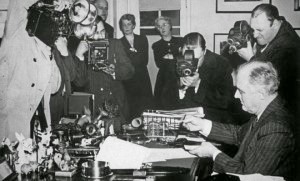 President Roosevelt signs the Lend-Lease bill. |
The Lend-Lease Act required countries requesting American assistance to provide the US with an exhaustive financial report. US Treasury Secretary Henry Morgenthau, Jr. was correct to recognize this requirement as something unprecedented in world affairs, claiming during a Senate Committee hearing that for the first time in history, one state and one government was willingly providing information to another about its own financial position.
With the help of the Lend-Lease Act, President Roosevelt's administration prepared to address a number of urgent issues, both foreign and domestic. First, its framework would make it possible to create new jobs in the US, which had not yet fully emerged from the extreme economic crisis of 1929-1933. Second, the Lend-Lease Act made it possible for the American government to exert a certain degree of influence over the countries on the receiving end of the lend-lease assistance. And third, by sending his allies weapons, goods, and raw materials, but not boots on the ground, President Roosevelt was able to stay true to his campaign promise, in which he pledged, "Your boys are not going to be sent into any foreign wars."
The lend-lease system was in no way designed to aid the USSR. The British were the first to request military assistance on the basis of this special leasing relationship (which was similar to an operating lease) at the end of May 1940, at a time when France's crushing defeat had left Great Britain with no military allies on the European continent. London asked Washington for 40-50 "old" destroyers, offering three payment options: getting them for free, paying in cash, or leasing. President Roosevelt quickly accepted the third option, and that transaction was completed in late summer of 1940.
 U.S. President Franklin D. Roosevelt (right) meets with Soviet Foreign Minister Vyacheslav Molotov (left) in the United States in 1942. |
At that point, staffers inside the US Treasury Department came up with the idea of taking the concept behind that private deal and extending it to apply to all intergovernmental relations. The War and Navy Departments were brought in to help develop the lend-lease bill, and on Jan. 10, 1941, the US presidential administration brought that act for consideration before both houses of Congress, where it was approved on March 11. Plus, in September 1941, after much debate the US Congress approved what was known as the Victory Program, the essence of which, according to US military historians (Richard Leighton and Robert Coakley), was that "America's contribution to the war would be in weapons, not armies."
On Oct. 1, 1941, People's Commissar for Foreign Affairs Vyacheslav Molotov, British Minister of Supply Lord Beaverbrook, and US Special Envoy Averell Harriman signed the First (Moscow) Protocol, which marked the beginning of the expansion of the lend-lease program to the Soviet Union. Several additional protocols were subsequently signed.
How Important Was the US Lend-Lease?
During the war, Soviet factories produced more than 29.1 million small arms of all major types, while only 152,000 small arms (0.5% of the total) were manufactured by American, British, and Canadian plants. Looking at all types of artillery systems of all calibers we see a similar picture -- 647,600 Soviet weapons and mortars vs. 9,400 of foreign origin, representing less than 1.5% of the total.
The numbers are less grim for other types of weapons: the ratio of domestic vs. allied tanks and self-propelled artillery was, respectively, 132,800 vs. 11,900 (8.96%), and for combat aircraft -- 140,500 vs. 18,300 (13%).
 South American bomber A-20 "Boston" (Douglas A-20 Havoc/DB-7 Boston), crashed at the airport in Nome, Alaska during transport to the Soviet Union under Lend-Lease Act. |
Out of the almost $46 billion that was spent on all lend-lease aid, the US allocated only $9.1 billion, i.e., only a little more than 20% of the funds, to the Red Army, which defeated the vast majority of the divisions from Germany and her military satellites.
During that time the British Empire was given more than $30.2 billion, France -- $1.4 billion, China -- $630 million, and even Latin America (!) received $420 million. Lend-lease supplies were distributed to 42 different countries.
But perhaps, despite the fact that the quantities of transatlantic assistance were fairly negligible, is it possible that it did play a decisive role in 1941, when the Germans were at the very gates of Moscow and Leningrad, and within 24-40 km from the Red Square?
Let's look at the statistics for arms shipments from that year. From the onset of the war until the end of 1941, the Red Army received 1.76 million rifles, automatic weapons, and machine guns, 53,700 artillery pieces and mortars, 5,400 tanks, and 8,200 warplanes. Of these, our allies in the anti-Hitler coalition supplied only 82 artillery weapons (0.15%), 648 tanks (12.14%), and 915 airplanes (10.26%). In addition, much of the military equipment that was sent -- in particular, 115 of the 466 tanks manufactured in the UK -- did not even make it to the front in the first year of the war.
If we convert these shipments of arms and military equipment into their monetary equivalent, then, according to the well-known historian Mikhail Frolov, DSc (Velikaya Otechestvennaya Voina 1941-1945 v Nemetskoi Istoriografii. [Great Patriotic War 1941-1945 in German historiography], St. Petersburg: 1994), "up until the end of 1941 -- the most difficult period for the Soviet state -- under the Lend-Lease Act, the US sent the USSR materials worth $545,000, out of the $741 million worth of supplies shipped to all the countries that were part of the anti-Hitler coalition. This means that during this extraordinarily difficult period, less than 0.1% of America's aid went to the Soviet Union.
"In addition, the first lend-lease shipments during the winter of 1941-1942 reached the USSR very late, although during those critical months Russia was able to put up an impressive fight against the German aggressors all on her own, without any assistance to speak of from the democracies of the West. By the end of 1942 only 55% of the scheduled deliveries had made it to the USSR."
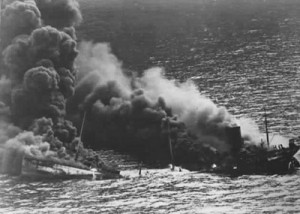 Defeat of the PQ-17 convoy. |
For example, in 1941 the United States promised to send 600 tanks and 750 aircraft, but actually sent only 182 and 204, respectively.
In November 1942, i.e., at the height of the battle for the Caucasus and Stalingrad, the arms deliveries practically came to a complete halt. Disruptions in shipments had already begun in the summer of 1942, when German aircraft and submarines almost entirely wiped out the infamous Convoy PQ 17 that was abandoned (at the order of the Admiralty) by the British destroyers assigned to escort it. Tragically only 11 of the original 35 ships arrived safely into Soviet ports -- a catastrophe that was used as a pretext to suspend subsequent convoys from Britain until September 1942.
A new convoy, the PQ 18, lost 10 of its 37 vessels along its route, and another convoy was not sent until mid-December 1942. Thus, for three and a half months, when one of the most decisive battles of the entire Second World War was being waged on the Volga, fewer than 40 ships carrying lend-lease cargo arrived intermittently in Murmansk and Arkhangelsk. For this reason, many were understandably suspicious that London and Washington were spending that time just waiting to see who would be left standing after the battle of Stalingrad.
As a result, between 1941 and 1942 only 7% of the wartime cargo shipped from the US made it to the Soviet Union. The bulk of the weapons and other materials arrived in the Soviet Union in 1944-1945, once the winds of war had decisively shifted.
What Was the Quality of the Lend-lease Military Equipment?
Out of the 711 fighter planes that had arrived in the USSR from the UK by the end of 1941, 700 were hopelessly antiquated models such as the Kittyhawk, Tomahawk, and Hurricane, which were significantly inferior to the German Messerschmitts and the Soviet Yakolev Yaks, both in speed and agility, and were not even equipped with guns. Even if a Soviet pilot managed to get a German flying ace positioned in the sights of his machine gun, those rifle-caliber guns were often completely useless against the German plane's rugged armor. As for the newest Airacobra fighter planes, only 11 were delivered in 1941. And the first Airacobra arrived in the Soviet Union disassembled, without any sort of documentation, having already long outlived its service life.
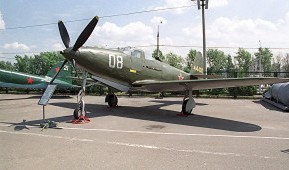 Bell P-39Q Airacobra |
Incidentally, this was also the case with the two squadrons of Hurricane fighters that were armed with 40-mm tank guns designed to engage German armored vehicles. But these fighter planes turned out to be so completely useless that they sat out the war mothballed in the USSR because no Red Army pilots could be found willing to fly them.
A similar situation was observed with the much-vaunted British light Valentine tanks that Soviet tank operators nicknamed "Valentinas," and the medium Matilda tanks, for which those tank operators reserved a more scathing epithet: "Farewell to Our Homeland." Their thin armor, highly-flammable gasoline-powered engines, and positively prehistoric transmissions made them easy prey for German gunners and grenade launchers.
According to Valentin Berezhkov, an interpreter for Joseph Stalin who took part in all the negotiations between Soviet leaders and Anglo-American visitors, Stalin was often deeply offended by British actions such as offering obsolete aircraft like the Hurricane as lend-lease handouts, instead of newer fighters like the Spitfire. Moreover, in September 1942, in a conversation with Wendell Willkie, a leader in the US Republican Party, Stalin asked him point-blank in front of the American and British ambassadors, William Standley and Archibald Clark Kerr: Why were the British and American governments supplying such poor-quality equipment to the Soviet Union?
He explained that he was primarily speaking of shipments of American P-40s instead of the much more up-to-date Airacobras, and added that the British were providing completely unsuitable Hurricane fighters, which were far inferior to what the Germans had. Stalin claimed that once when the Americans were preparing to ship 150 Airacobras to the Soviet Union, the British had intervened and kept them for themselves. "We know that the Americans and British have planes that are equal to or better than the German models, but for some reason many of those are not making it into the Soviet Union."
The American ambassador, Admiral Standley, knew nothing about this, but the British ambassador, Archibald Clark Kerr, admitted that he was aware of the Airacobra event, but he defended their redirection with the excuse that in British hands those fighters would be much more valuable to their common Allied cause than if they ended up in the Soviet Union...
Nonlethal Lend-Lease Aid
Besides weapons, other supplies were also provided under lend-lease. And those figures are absolutely indisputable indeed.
Specifically, the USSR received 2,586,000 tons of aviation fuel, an amount equal to 37% of what was produced in the Soviet Union during the war, plus almost 410,000 automobiles, making up 45% of the Red Army's vehicle fleet (not counting cars captured from the enemy). Food shipments also played a significant role, although very little was provided during the first year of the war, and the US supplied only about 15% of the USSR's canned meat and other nonperishables.
This support also included machine tools, railway tracks, locomotives, rail cars, radar equipment, and other useful items without which a war machine can make little headway.
Of course this list of lend-lease aid looks very impressive, and one might feel sincere admiration for the American partners in the anti-Hitler coalition, except for one tiny detail: US manufacturers were also supplying Nazi Germany at the same time ...
For example, John D. Rockefeller Jr. owned a controlling interest in the Standard Oil corporation, but the next largest stockholder was the German chemical company I.G. Farben, through which the firm sold $20 million worth of gasoline and lubricants to the Nazis. And the Venezuelan branch of that company sent 13,000 tons of crude oil to Germany each month, which the Third Reich's robust chemical industry immediately converted into gasoline. But business between the two nations was not limited to fuel sales -- in addition, tungsten, synthetic rubber, and many different components for the auto industry were also being shipped across the Atlantic to the German Führer by Henry Ford. In particular, it is no secret that 30% of all the tires produced in his factories were used to provision the German Wehrmacht.
The full details of how the Fords and Rockefellers colluded to supply Nazi Germany are still not fully known because those were strictly guarded trade secrets, but even the little that has been made public and acknowledged by historians makes it clear that the war did not in any way slow the pace of the US trade with Berlin.
Lend-Lease Was Not Charity
There is a perception that lend-lease aid was offered by the US out of the goodness of its heart. However, this version does not hold up upon closer inspection. First of all, this was because of something called "reverse lend-lease." Even before the Second World War had ended, other nations began sending Washington essential raw materials valued at nearly 20% of the materials and weapons the US had shipped overseas. Specifically, the USSR provided 32,000 tons of manganese and 300,000 tons of chrome ore, which were highly prized by the military industry. Suffice it to say that when German industry was deprived of the manganese from the rich deposits in Nikopol as a result of the Soviet Nikopol-Krivoi Rog Offensive in February 1944, the 150-mm frontal armor on the German "Royal Tiger" tanks turned out to be much more vulnerable to Soviet artillery shells than the 100-mm armor plate previously found on the ordinary Tiger tanks.
In addition, the USSR paid for the Allied shipments with gold. In fact, one British cruiser, the HMS Edinburgh, was carrying 5.5 tons of that precious metal when it was sunk by German submarines in May 1942.
The Soviet Union also returned much of the weaponry and military equipment after the war, as stipulated under the lend-lease agreement. In exchange they were issued an invoice for $1,300 million. Given the fact that lend-lease debts to other nations had been written off, this seemed like highway robbery, and Stalin demanded that the "Allied debt" be recalculated.
Subsequently the Americans were forced to admit their error, but they inflated the interest owed in the grand total, and the final amount, including that interest, came to $722 million, a figure that was accepted by the USSR and the US under a settlement agreement signed in Washington in 1972. Of this amount, $48 million was paid to the US in three equal installments in 1973, but subsequent payments were cut off when the US introduced discriminatory practices in their trade with the USSR (in particular, the notorious Jackson-Vanik Amendment).
The parties did not return to the discussion of lend-lease debt until June 1990, during a new round of negotiations between Presidents George Bush Sr. and Mikhail Gorbachev, during which a new deadline was set for the final repayment -- which would be in 2030 -- and the total outstanding debt was acknowledged to be $674 million.
After the collapse of the Soviet Union, its debts were categorized as either sovereign debt (the Paris Club) or debts to private banks (London Club). The lend-lease debt was a liability owed to the US government and is part of the Paris Club debt, which Russia repaid in full in August 2006.
Direct Speech
US President Franklin D. Roosevelt explicitly stated that aid to Russia was money well spent, and his successor in the White House, Harry Truman, was quoted in the pages of New York Times in June 1941 as saying, "If we see that Germany is winning the war, we ought to help Russia; and if that Russia is winning, we ought to help Germany, and in that way let them kill as many as possible ..."
The first official assessment of the role played by lend-lease aid in the larger victory over Nazism was provided by the chairman of Gosplan, Nikolai Voznesensky, in his work Voennaya Ekonomika SSSR v Period Otechestvennoi Voiny (Soviet military complex during the Great Patriotic War) (Moscow: Gospolitizdat, 1948), where he wrote, "If one compares the quantity of industrial goods sent by the Allies to the USSR with the quantity of industrial goods manufactured by socialist factories in the Soviet Union, it is apparent that the former are equal to only about 4% of what was produced domestically during the years of the war economy."
American scholars and military and government officials themselves (Raymond Goldsmith, George Herring, and Robert H. Jones) acknowledge that all the Allied aid to the USSR was equal to no more than 1/10 of the Soviets' own arms production, and the total quantity of lend-lease supplies, including the familiar cans of Spam sarcastically referred to by the Russians as the "Second Front," made up about 10-11%.
Moreover, the famous American historian Robert Sherwood, in his landmark book, Roosevelt and Hopkins: An Intimate History (New York: Grossett & Dunlap, 1948), quoted Harry Hopkins as claiming the Americans "had never believed that our Lend-Lease help had been the chief factor in the Soviet defeat of Hitler on the eastern front. That this had been done by the heroism and blood of the Russian Army."
British Prime Minister Winston Churchill once called lend-lease "the most unselfish and unsordid financial act of any country in all history." However, the Americans themselves admitted that lend-lease brought in considerable income for the US. In particular, former US Secretary of Commerce Jesse Jones stated that the US had not only gotten its money back via supplies shipped from the USSR, but the US had even made a profit, which he claimed was not uncommon in trade relations regulated by American state agencies.
His fellow American, the historian George Herring just as candidly wrote that lend-lease was not actually the most unselfish act in the history of mankind, but rather an act of prudent egotism, with the Americans fully aware of how they could benefit from it.
And that was indeed the case, as lend-lease proved to be
an inexhaustible
source of wealth for many American corporations. In fact, the United
States
was the only country in the anti-Hitler coalition to reap significant
economic
dividends from the war. There's a reason that Americans often refer to
WWII
as "the good war," as evidenced, for example, in the title of the book
by the
famous American historian Studs Terkel: The Good War: An Oral
History of World War II (1984). With unabashed cynicism he quoted,
"While the rest of the world came out bruised and scarred and nearly
destroyed, we came out with the most unbelievable machinery, tools,
manpower, money ... The war was fun for America. I'm not talking about
the
poor souls who lost sons and daughters. But for the rest of us the war
was a
hell of a good time."

Soviet aircraft manufacturing plant, 1943.
Evgeniy Spitsyn is a Russian historian and blogger.
(Oriental Review, May 12, 2015)
Read The Marxist-Leninist Daily
Website: www.cpcml.ca
Email: editor@cpcml.ca
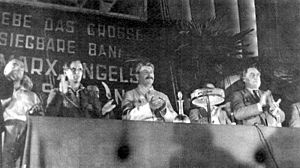
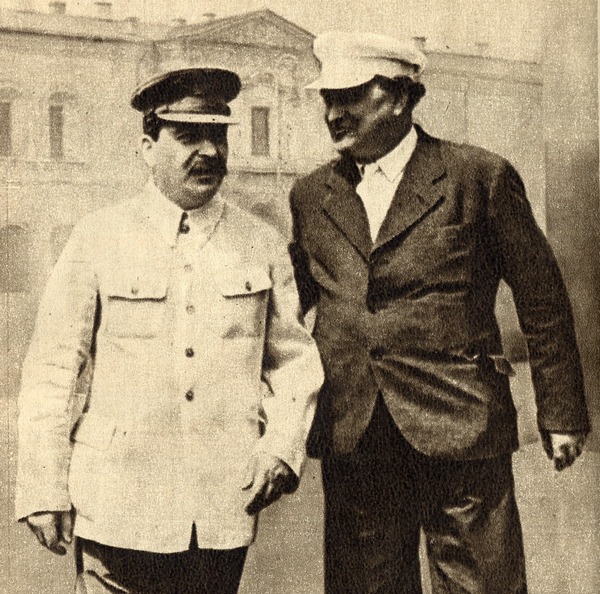

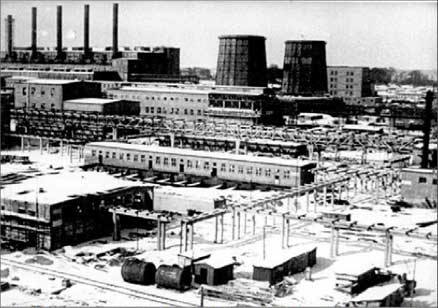
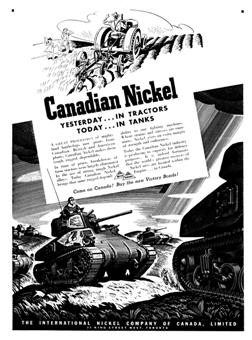
 "With a knowledge of the
personalities and the already
established basic
attitude of the nickel trust, I consider it to be certain that such a
decree would
be appreciated by the trust; but for itself, too, it will see in the
supply of
Germany a desired protection against a possible Russian seizure...
Obviously,
on the side of the trust everything will be avoided which could have
the effect
of making further co-operation impossible with us after the end of the
war."
"With a knowledge of the
personalities and the already
established basic
attitude of the nickel trust, I consider it to be certain that such a
decree would
be appreciated by the trust; but for itself, too, it will see in the
supply of
Germany a desired protection against a possible Russian seizure...
Obviously,
on the side of the trust everything will be avoided which could have
the effect
of making further co-operation impossible with us after the end of the
war."
 The Auto Union -- a car maker created in 1932
after the merger of the
German car brands Audi, DKW, Horch and Wanderer -- was headed by Dr.
Richard Bruhn, who is a particular focus of the study.
The Auto Union -- a car maker created in 1932
after the merger of the
German car brands Audi, DKW, Horch and Wanderer -- was headed by Dr.
Richard Bruhn, who is a particular focus of the study.